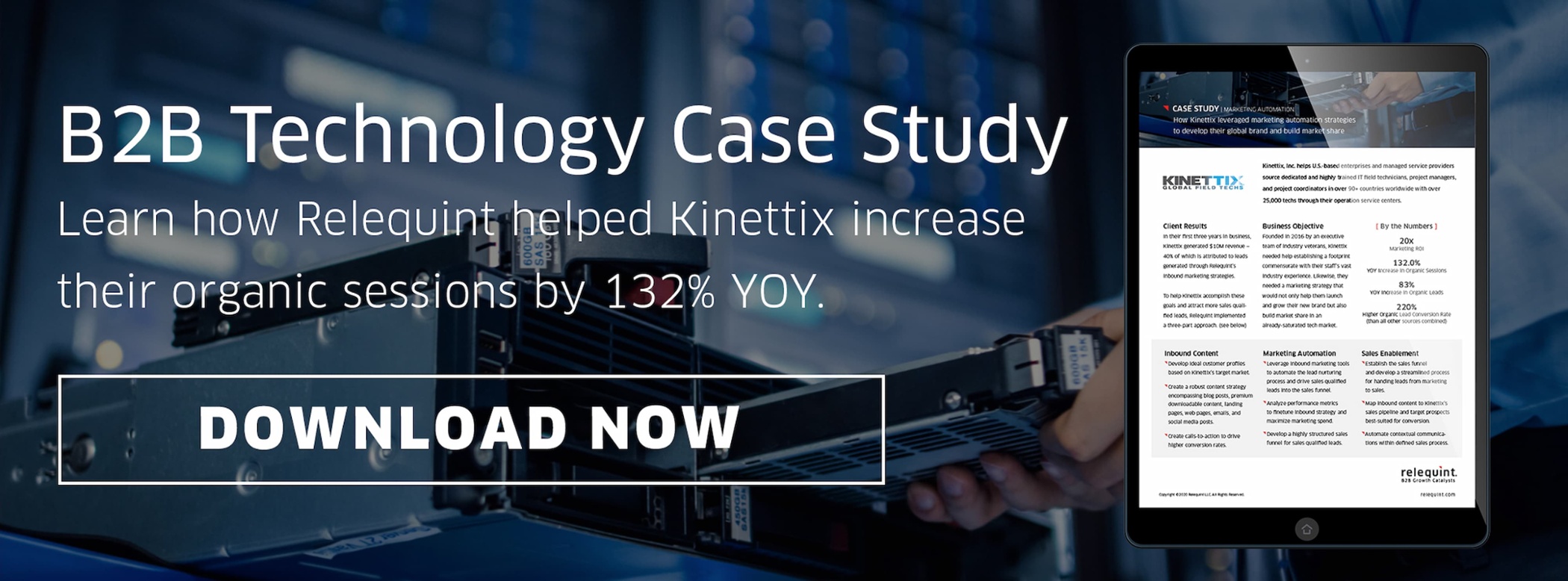We recently published a blog about which KPIs B2B technology companies should focus on. Now, we'd like to dig deeper and look at which metrics you should measure to determine how effective your blogging strategy is and specifically how to increase your content marketing ROI.
Blogging Metrics that Matter
No one measure determines blogging success. Since you need your blog to serve different roles, a variety of metrics will tell you how well it's meeting or exceeding your business goals.
1. Blog Visits
To get blogging results, you need to generate traffic to your website. But this is only the beginning. Use a combination of organic social sharing, pay-per-click and sponsored content, networking, and remarketing to drive traffic to your B2B technology blog.
Be sure to compare blog visits month-to-month and year-over-year. The more visits you get over time, the more your blogs will be indexed and backlinked, and the better engagement you’ll get.
2. Traffic Sources
Understanding where traffic comes from allows you to shift more resources to that channel...but only if you also see that this traffic is high quality.
High quality traffic refers to users who:
- Are interested in and engaged with your content
- Are more likely to convert
- Are or will be looking for your product or service
You’ll know whether your traffic is high quality by looking at your engagement metrics, conversion rates, and sales attribution. Look for deals that come through your pipeline where the prospect’s first touchpoint was a blog post.
3. Blog Homepage Visits
Visits to your main blog page mean people are actively searching for answers and content in your blog posts. This is more intentional engagement. They see you as a knowledgeable website or person, and they directly seek your solutions.
To increase this kind of engagement, add internal links to other relevant inbound content throughout each blog to show visitors you have a lot of resources to offer. They'll want to subscribe and keep coming back.
4. Average Views per Post
We all get excited about viral content. But at the end of the day, if you have 1-2 posts getting all the views or driving all the leads, you may be wasting significant resources. You might not really understand what your B2B technology audience wants from your site that will help you get a handle on blogging KPIs and meet the goals your superior has set for you.
Go through your content catalog with a fine-toothed comb. Analyze the blogs that are getting the most attention. If there’s a particular topic that always performs well, produce more content in that area. The more you speak to your audience’s unique pain points, the more views you’ll get.
Like with blog visits, compare your views month-to-month and year-over-year for a wide angle view of your content marketing ROI.
5. Average Inbound Links
Links still matter in 2021. They are a primary ranking factor for Google, so they significantly impact SEO.
Similar to views, you don't want all of your links coming into a handful of posts. You need a broader likability strategy.
Thanks to machine learning — which you can use too, by the way — Google's algorithm gets smarter all the time. Google can tell when we're trying to manipulate links and rankings, and it will penalize sites. To future proof your SEO, you need to create content that attracts natural links.
6. Leads Generated
Ultimately, your content marketing ROI is determined by how many leads your blog generates and the quality of those leads. Like we said before, you’ll want to take a look at your pipeline and see how many of your Closed Won deals are attributed to your blog and other types of inbound content.
If you’re not seeing high-quality leads coming from your blog, then make sure you’re tailoring content to your buyer persona and their unique needs and pain points. Map out your typical buyer's journey and build a content marketing strategy that focuses on delivering the right message at the right time to the right person to lead a target through the journey organically.
7. Email Subscribers
Subscribing takes more effort than liking a LinkedIn post or retweeting a blog post on Twitter — so the more RSS and email subscribers, the more engaged your audience is.
Continue to publish and share content that is relevant and helpful to your B2B technology audience to grow this list and increase your content marketing ROI.
Also, leverage your RSS and email subscribers to promote other types of content. Make sure they're the first to know about that new case study you just published. Segment your subscribers using behavioral data and send them monthly newsletters based on the types of content they interact most. This strategy allows you to create a more personalized experience and increase ROI.
Is Your Blog Increasing Your Content Marketing ROI?
To answer this question, look at these seven KPIs holistically. Increasing your content marketing ROI and driving sales qualified leads requires the “big picture.” Review all performance metrics in context to determine what’s working and what’s not, and make changes to your B2B marketing strategy accordingly.
For a real world example, download our case study and learn how a B2B technology company is leveraging its inbound content to increase organic leads by 83% YOY.![]()







 By
By 
